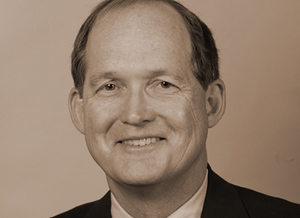
The Four Keys to Success: Q&A with Commerce Bank CEO David Kemper
 Once a year, Bank Director magazine ranks publicly traded U.S. banks based on profitability, capitalization and asset quality in the Bank Performance Scorecard, and there is one bank that often seems to appear high on the list. Commerce Bancshares, Inc., a $20.7-billion asset holding company for Commerce Bank headquartered in Kansas City, Missouri, was the fourth best performing bank in the $5-billion to $50-billion asset size category this year.
Once a year, Bank Director magazine ranks publicly traded U.S. banks based on profitability, capitalization and asset quality in the Bank Performance Scorecard, and there is one bank that often seems to appear high on the list. Commerce Bancshares, Inc., a $20.7-billion asset holding company for Commerce Bank headquartered in Kansas City, Missouri, was the fourth best performing bank in the $5-billion to $50-billion asset size category this year.
Led by David Kemper, a seasoned banker with more than two decades as CEO of the company, Commerce Bancshares, Inc. weathered the financial crisis without TARP assistance, boasts an extremely high customer satisfaction rating, and consistently outperforms the market regardless of the financial climate. The bank had a 12.39 percent return on average equity last year. Bank Director interviewed David Kemper to get his insight on the keys to consistently high performance.
BD: What are some of the attributes contributing to Commerce Bancshares, Inc.’s continued success?
We’ve had a very strong credit culture. We are a relationship bank, so most of our borrowing customers are also customers who buy other things from the bank. That tends to mean we try to know more about the customer, and they are also primarily in our geographical footprint or in industries where we do a lot of business and have developed an expertise. So, know your customer and know the markets and industries you deal in. That’s been our philosophy for many, many years and that tends to lead to better credit performance.
On the capital side, we have always felt that a strong capital base allows you more flexibility. It allows you the ability to take opportunities, such as expanding your balance sheet or acquiring another bank. So we have always had the philosophy of running with strong capital, and we are very supportive of stronger capital in the banking industry. It also will tend to improve pricing as people will have to price off of a higher capital ratio.
BD: Commerce Bancshares, Inc. has ranked near the top of the list for customer service in J.D. Power and Associates’ ranking. What are your strategies for achieving this?
We have always said that we are in the service business, and we have four major measurements that all of our associates know. One is top line revenue growth; we feel that is very important that a strong organization be growing their top line. Second is profitability. Third is customer satisfaction and fourth is employee satisfaction. So we pay attention to all four of those, and as you have said, customer and employee satisfaction is a top priority. It goes with the community and relationship aspect of our bank. We just think that gives you an edge.
Obviously, retention of customers is just a good way to do business; it makes it better for both the provider and the customer, and it’s also more profitable. The last thing you want is turnover in customers. We really pay attention. It’s been an advantage in this environment where you have had a lot of the large national banks kind of pull back from the market we are in. Frankly, we’ve got better personnel in those markets, and that leads to better customer satisfaction.
We are a large community bank with expertise in certain areas such as payments and money management, but we very much want to be part of the community. We understand it better, and that’s just been a winning formula.
BD: Looking ahead, what are the key challenges for your institution?
It’s pretty obvious that some of the short-term economic situations of a deleveraging economy means very slow loan growth. These low interest rates are very difficult for both savers and banks because we have a very difficult time getting any kind of interest spread on money.
Everybody complains about regulation, but it is adding a lot of cost, and I think it is going to drive a lot of consolidation in the industry. It is going to put a lot of community banks out of business. Those are challenges the industry faces: tough top line growth, tough loan demand, tough interest rate environment, and too much cost.
If you look at why we have done pretty well, it is because we have had great credit quality and we have really worked on expense control. We are determined to be a low unit cost producer and be very efficient.
[The banking industry] is going to get smaller and more focused. The tough-minded people who picked the right niches and got the right cost controls will do pretty well. That’s the way we view the world and I think we have executed pretty well with that kind of view.
*The number one, two and three banks in the $5-billion to $50-billion asset size category were Santa Barbara, California-based Pacific Capital Bancorp; Miami Lakes, Florida-based BankUnited Inc.; and San Francisco-based First Republic Bank.

